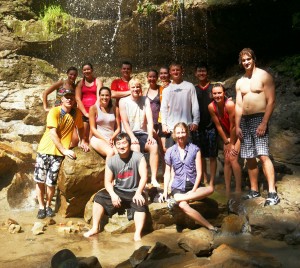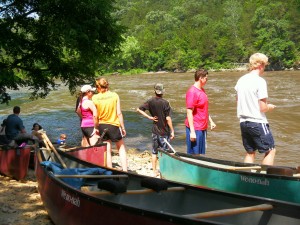
Student researchers, professors, professor's family members stop at a waterfall along the Blue Earth River.
“There’s been a glitch,” Jeff Jeremiason, professor of chemistry and environmental studies mentioned in passing to a research student and myself as we stood sweating in the humidity. The much-anticipated annual canoe trip had already been postponed twice due to rain, and, despite the 118-degree heat index, we were ready for some physical exercise and summer sunshine. Research students, professors, and the family members of professors, had the opportunity to take a break from their labs for an afternoon and canoe a stretch of the Blue Earth River, located just a few minutes south of Mankato.
The glitch turned out to be a broken air conditioner in one of the vans, resulting in an uncomfortable, but bearable, 30-minute ride to the river. Upon arrival at Rapidan Dam Park (and after many a “dam” joke) we unstuck ourselves from the cheap vinyl van seats and unloaded canoes from the racks. The other half of our crew arrived 20 minutes later than us, with news of an even bigger glitch: the second van (the one with air conditioning) broke down only minutes from the canoe launch. Suddenly, enduring a hot sticky ride didn’t seen so bad.
After retrieving the remaining canoes from the broken-down van, we were back in action. Students paired up and launched their canoes into the river. Almost immediately, biology researchers Alex Chubick (’13, biochemistry) and Michael Sterling (’14, chemistry) hit a cement block in the water, flipped their canoe, and ended up soaked in the river. It would not be their last tip. In fact, it was only the first of four.
A mile of light paddling brought us to a gorge carved out of soft sandstone. Names carved into

Students wait for the second van carrying researchers and two more canoes to arrive, unaware that the vehicle broke down a few miles from the river.
therock lined the gorge on both sides, some fresh, and others decades old, their lines softened by rain and high water. Picking our way over rocks and splashing through ankle to hip high water, we arrived at a waterfall. Students stepped under the water, remarkably cool and refreshing, heads bent under the pressure. “This is the best back massage,” Sterling commented after stepping away from the falls to make room for another student. Hours later, while canoeing the last stretch of the river, Maja Johnson (’13, biology) asked me, “Have you ever felt anything as good as standing under that first waterfall?” I couldn’t say I had.
Although we didn’t see a wide display of wildlife, two bald eagles, both just starting to develop the distinguishing white head and tail feathers, soared above the river for several minutes. For a number of students, including California native Laura Leland (’13, biochemistry), this was the first time they had seen eagles in the wild. “The bald eagles flying above us were so awesome and majestic. We passed their nest too, which was ginormous,” Leland said. According to the Delaware Valley Raptor Center, bald eagles build the largest nests constructed by a pair of birds in the world, weighing anywhere from hundreds to thousands of pounds. Seeing a nest right off of shore was a truly an awe-inspiring close to an eventful day.